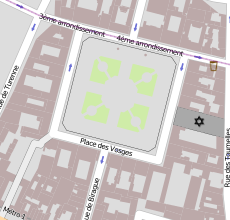Place des Vosges

Map of the Place des Vosges
|
|
| Length | 140 m (460 ft) |
|---|---|
| Width | 140 m (460 ft) |
| Arrondissement | 3rd, 4th |
| Quarter | Archives. Arsenal. |
| From | rue de Birague, 11 bis |
| To | rue de Béarn, 1 |
| Construction | |
| Completion | July 1605 |
Coordinates: 48°51′20″N 2°21′56″E / 48.85556°N 2.36556°E
The Place des Vosges (French pronunciation: [plas de voʒ]), originally Place Royale, is the oldest planned square in Paris and one of the finest in the city. It is located in the Marais district, and it straddles the dividing-line between the 3rd and 4th arrondissements of Paris. It was a fashionable and expensive square during the 17th and 18th centuries, and was one of the reasons Le Marais become so fashionable for the Parisian nobility.
Originally known as the Place Royale, the Place des Vosges was built by Henri IV from 1605 to 1612. A true square (140 m × 140 m), it embodied the first European program of royal city planning. It was built on the site of the Hôtel des Tournelles and its gardens: at a tournament at the Tournelles, a royal residence, Henri II was wounded and died. Catherine de Medicis had the Gothic complex demolished, and she moved to the Louvre Palace.
The Place des Vosges, inaugurated in 1612 with a grand carrousel to celebrate the engagement of Louis XIII and Anne of Austria, is the prototype of all the residential squares of European cities that were to come. What was new about the Place Royale in 1612 was that the housefronts were all built to the same design, probably by Baptiste du Cerceau, of red brick with strips of stone quoins over vaulted arcades that stand on square pillars. The steeply-pitched blue slate roofs are pierced with discreet small-paned dormers above the pedimented dormers that stand upon the cornices. Only the north range was built with the vaulted ceilings that the "galleries" were meant to have. Two pavilions that rise higher than the unified roofline of the square center the north and south faces and offer access to the square through triple arches. Though they are designated the Pavilion of the King and of the Queen, no royal personage has ever lived in the aristocratic square, except for Anne of Austria in the Pavillion de la Reine, for a short while. The Place des Vosges initiated subsequent developments of Paris that created a suitable urban background for the French aristocracy and nobility.
...
Wikipedia

